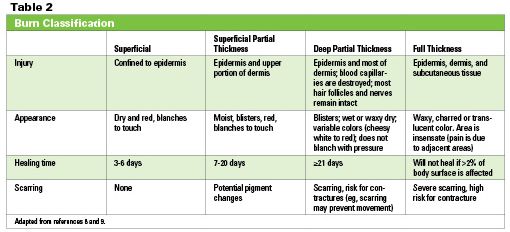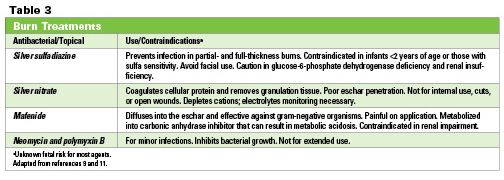Preventing Painful Burns and Scalds
Burns and scalds disproportionately affect children and seniors. Preventing them should be a priority, but if burns and scalds do occur, proper treatment can lessen the pain and chance of infection.
Burns and scalds disproportionately affect children and seniors. Preventing them should be a priority, but if burns and scalds do occur, proper treatment can lessen the pain and chance of infection.
Eventually, everyone suffers a burn or scald. Burns are defined by their source: fire/flame, contact with hot object (eg, iron), chemical, gaseous, electrical, sun, and radiation. A scald is a burn from hot liquids or steam (Table 11-5).
Burns affect children and elders disproportionately, often with more severe consequences. Young children are scalded more than older children, who suffer more flame burns.6 With their thin skin, children lose more fluids and have a greater systemic

inflammatory response.6 Among elders, burns and fire-related injuries are the second leading cause in home accidents. Elder burn victims have longer hospitalizations, poorer prognosis, and are more apt to be transferred to rehabilitative or long-term care facilities.2,5
Classifications
Skin is comprised of 3 layers: the outermost epidermis, composed of cornified epithelial cells; the middle dermis that preserves fluid balance, prevents and fights disease, controls body temperature, and senses stimuli; and the bottom hypodermis of adipose and connective tissue.7
Burns were originally classified as first, second, and third degree, based on visual inspection. Because the skin’s appearance can change within days of injury, however, current nomenclature classifies burns by depth (Table 28,9).2
Clinicians base treatment on total body surface area (TBSA) affected, estimating with the rule of nines: each arm and head equals 9%; each leg is 18%; front torso and back are 18% each; and genitalia is 1%.7 Alternatively, a person’s palm and extended hand is approximately 1% TBSA—a useful benchmark for small burns.10
Treatment

Superficial burns are treated with nonsteroidal anti-inflammatory drugs (NSAIDs) or acetaminophen. A topical antibiotic may be used if infection risk is high. The goal of acute treatment for partial- and full-thickness burns is minimizing further damage. All partial- and full-thickness burns are covered with nonadhesive sterile dressings. Burns of <10% of TBSA can be treated on an outpatient basis. Those above 10% usually required hospitalization.8
Thermal injury initiates a stress response: release of inflammatory mediators, pyrexia, increased catabolism, hyperglycemia, increased capillary permeability, and progressive hyperdynamic circulation.6 Analgesia and infection prevention are crucial. Practitioners use broad-spectrum antimicrobial scrubs such as chlorhexidine gluconate with adequate analgesia to remove devitalized tissue and debris (eg, clothing adhering to skin). They dress the wound with various topicals11 and intubate patients with inhalation burns. Acetaminophen, NSAIDs, and/or opioids are used as needed for patients’ pain. Steroids are ineffective.9
Clinicians halt the burning process using cold water for at least 10 minutes; this also reduces pain, swelling, and infection risk. Electrical burns require close monitoring, as cardiac arrhythmia can occur up to 72 hours after the injury. Surgical excision and skin grafting for full-thickness burns ideally occur within 72 hours.8
When a large TBSA is affected, risk for dehydration increases, especially in children (who have more extracellular fluid than adults).7 Tetanus immunization and prophylactic antibiotics may be administered.
Skin grafts are required for large full-thickness burns. An autologous skin graft uses an individual’s own skin, whereas an allograft uses the skin from another individual or a cadaver. Artificial skin has been used since the 1990s and is used when burns cover 80% to 90% of TBSA and/or when skin grafts are not an immediate option.12
Follow-up care addresses psychological sequelae of scarring and contractures and posttraumatic stress disorders. Up to 60% of patients with significant burn injuries become depressed.10 Family members may be stricken with guilt if their carelessness contributed to a child’s injury, and will also need care.
Counseling
For superficial burns, patients should apply a nonperfumed moisturizing cream, avoiding products with high lanolin content.8 The healing process may include itching; discourage picking or scratching. Direct patients to use sun-block on healed burns for up to a year.
Emphasize the importance of following the provider’s advice on cleaning the area and changing the dressing. Warn about picking blisters; it increases infection risk. Stress that wound color changes (increased redness, brown, black, or green) often mean the wound is infected and needs immediate medical attention.11
Recommend nutritional supplements. Basal metabolic rate increases as the percentage of TBSA increases11; increasing protein, carbohydrate, vitamin (vitamins C and E) and mineral needs (zinc) may limit oxidative damage and promote healing.13 While aloe vera is popular for burn healing, insufficient evidence exists to support its use.14
In homes with children, stress burn prevention including reduced water temperature (120oF), establishing “no” zones (eg, oven, microwave), avoiding accidental spills, and testing food temperatures. Avoid microwave cooking, which distributes heat unevenly.15 Children may interpret pain as punishment. Parents should emphasize the accidental nature of the injury. Inform parents that it is not unusual for injured children to regress developmentally.7
Notify proper authorities if abuse is suspected; up to 10% of abused children are burned or scalded.9 Signs of abuse include clear injury lines (scalds are uneven in shape), a shape consistent with cigarette burns, unwitnessed injury, conflicting stories, or burn attributed to another child.9
Refer patients seeking online information and support to Burn Survivor (www.burnsurvivor.org) or the Phoenix Society (www.phoenix-society.org).
Final Thought
The majority of burns are preventable. Proactive safety is key, but all too often prevention occurs after a burn has happened. â–

Dr. Zanni is a psychologist and health systems consultant based in Alexandria, Virginia.
References
1. Lowell G, Quinlan K, Gottlieb LJ. Preventing unintentional scald burns: moving
beyond tap water. Pediatrics. 2008;122:799-804.
2. Davidge K, Fish J. Older adults and burns. Geriatrics and Aging. 2008;11;270-75
3. American Burn Association. Burn incidence and treatment in the US: 2007 fact sheet. Available at http://www.ameriburn.org/resources_factsheet.php. Accessed December 28, 2009.
4. American Burn Association. National Burn Repository, Report of Data From 1999 - 2008. Available at http://www.ameriburn.org/2009NBRAnnualReport.pdf. Accessed December 28, 2009.
5. Centers for Disease Control and Prevention (CDC). Nonfatal scald-related burns
among adults aged >/=65 years--United States, 2001-2006. MMWR Morb Mortal Wkly
Rep. 2009 Sep 18;58(36):993-6.
6. Fenion S, Nene S. Burns in children. Available at http://www.medscape.com/viewarticle/560164. Accessed December 22, 2009.
7. Balseven-OdabaÅŸi A, Tümer AR, Keten A, Yorganci K. Burn injuries among
children aged up to seven years. Turk J Pediatr. 2009 Jul-Aug;51(4):328-35.
8. Morgan ED, Bledsoe SC, Barker J. Ambulatory management of burns. Am Fam
Physician. 2000 Nov 1;62(9):2015-26, 2029-30, 2032.
9. Goodis J, Schrage E. Burns, thermal. Available at http://emedicine.medscape.com/article/769193-overview. Accessed December 22, 2009.
10. Enoch S, Roshan A, Shah M. Emergency and early management of burns and scalds.BMJ. 2009 Apr 8;338:b1037. doi: 10.1136/bmj.b1037.
11. Murray C, Hospenthal D. Burn wound infections. Available at http://emedicine.medscape.com/article/213595-overview. Accessed December 22, 20009.
12. National Institute of General Medical Sciences. Treating severe burns with artificial skin. Available at http://www.nigms.nih.gov/Publications/Factsheet_ArtificialSkin.htm. Accessed December 27, 2009.
13. Burn Survivor Resource Center. Medical care guide. Available at http://www.burnsurvivor.com/medical.html. Accessed December 29, 2009.
14. National Center for Complementary and Alternative Medicine. Aloe Vera. Available at http://nccam.nih.gov/health/aloevera/. Accessed December 29, 2009.
15. Mayo Clinic Staff. Child safety: how to prevent burns. Available at http://www.mayoclinic.com/print/child-safety/CC00044/METHOD=print. Accessed December 28, 2009.

